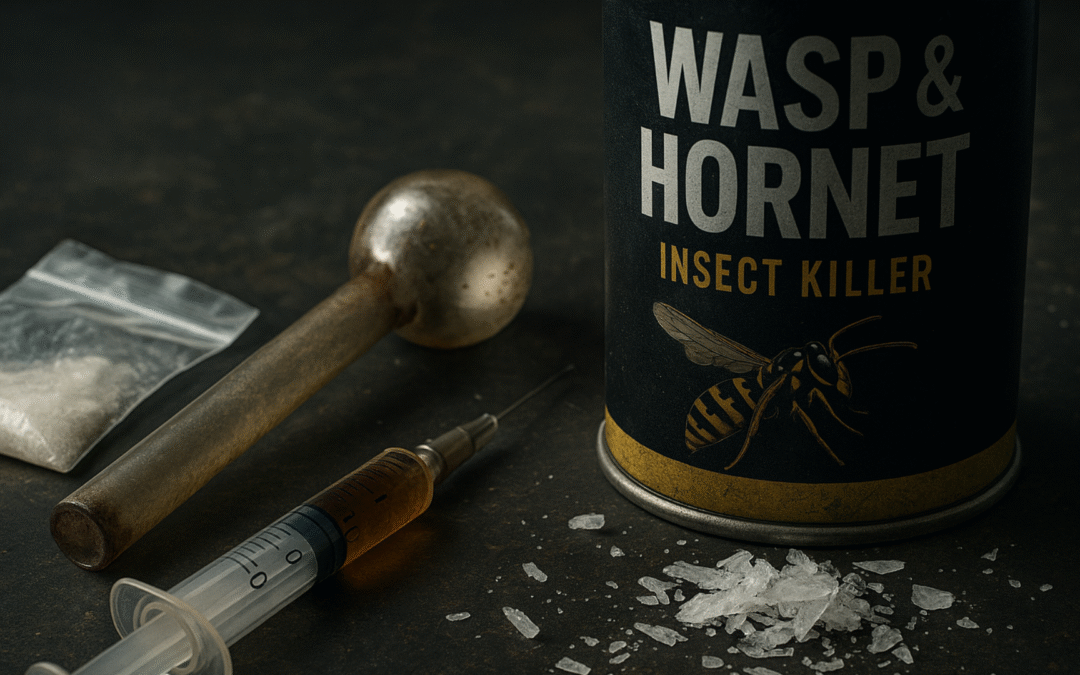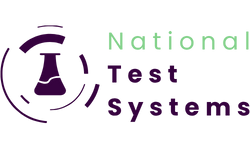Expectations: Understanding the Limitations of Point-of-Care Testing
Not all tests are created equal. In this free live webinar, you’ll uncover the benefits, science ,and shortfalls of rapid diagnostic testing. Hosted by Chief Product Officer, Eric Malis, we’ll cover everything from detection windows to cross-reactions and the importance of setting the right expectations. Don’t miss this opportunity to sharpen your knowledge and make better-informed testing decisions.

Wasping: The Dangerous Trend of Meth and Insecticide Abuse

In the realm of substance abuse, a disturbing and dangerous trend has emerged known as “wasping.” This practice involves combining methamphetamine with insecticides, particularly wasp spray, to achieve a toxic high. The phenomenon has gained traction in certain regions, but the consequences are dire, potentially leading to severe health complications or even death. This article delves into the nature of wasping, its effects, and the urgent need for awareness and intervention.
What is Wasping?
Wasping refers to the act of mixing methamphetamine with wasp spray or using wasp spray on its own as a drug. Wasp spray contains chemicals such as pyrethroids and pyrethrins, which are neurotoxic to insects. When inhaled, ingested, or injected by humans, these chemicals can cause severe neurological and cardiovascular effects. Some individuals use wasp spray to mimic the effects of methamphetamine, as the chemicals can produce a temporary feeling of euphoria or heightened alertness.
Why Are People Turning to Wasp Spray?
The use of wasp spray as a drug is primarily driven by desperation and accessibility. Methamphetamine is a highly addictive stimulant, but it can be costly or difficult to obtain. In contrast, wasp spray is readily available in stores and relatively inexpensive. For those struggling with addiction or unable to afford meth, wasp spray becomes a dangerously accessible alternative. Additionally, the misconception that wasp spray is a “legal” high contributes to its misuse, despite its potentially lethal effects.
Effects of Wasping
The effects of wasping are highly unpredictable and depend on the method of administration, the amount used, and the individual’s overall health. Common side effects include:
- Severe agitation and aggression
- Hallucinations and psychosis
- Rapid heart rate and hypertension
- Nausea and vomiting
- Seizures
- Respiratory distress
- Organ failure
The neurotoxic chemicals in wasp spray can damage the nervous system, leading to long-term cognitive and motor impairments. Additionally, chronic exposure can result in chemical burns, organ damage, and even death.
The Legal Implications
While the purchase of wasp spray is legal, using it as a drug is not. Law enforcement and health officials are increasingly aware of wasping as a public health concern. In some areas, retailers have begun to restrict the sale of large quantities of insecticide, aiming to curb its misuse. However, the challenge lies in identifying and addressing the underlying issues of addiction that drive individuals to seek out such dangerous alternatives.
Drug Testing and Detection
Detecting the use of wasp spray as a drug can be challenging, as standard drug tests typically do not screen for pyrethroids or pyrethrins, the primary chemicals in wasp spray. However, methamphetamine use can still be detected through conventional drug testing methods, including urine, blood, and hair tests. If wasp spray is suspected, toxicology screenings may be required to identify specific insecticide chemicals. These tests can help identify chemical exposure but are not typically part of standard drug panels. As the practice of wasping gains more attention, specialized testing protocols may become more common in regions where its use is prevalent.
Addressing the Crisis
Addressing the wasping crisis requires a multi-faceted approach that includes education, prevention, and intervention. Public health campaigns must raise awareness about the severe risks associated with using wasp spray as a drug. Addiction treatment programs need to emphasize the dangers of toxic substance use and provide accessible resources for those struggling with methamphetamine addiction. Additionally, community support systems can play a critical role in preventing substance abuse by offering education, outreach, and counseling services.
Conclusion
Wasping is a dangerous and alarming trend that highlights the lengths to which individuals struggling with addiction will go to achieve a high. The misuse of insecticides as a drug poses life-threatening risks, and public awareness is crucial in preventing further harm. By addressing the root causes of addiction, providing accessible treatment options, and educating communities about the dangers of toxic substance use, we can work to mitigate the devastating effects of wasping and other dangerous drug trends.
Beyond the Rapid Test: The Critical Role of Lab Confirmations in Toxicology
When a rapid toxicology test yields a positive result, the next step is crucial—confirmation through laboratory testing. While rapid tests provide quick insights, they can sometimes lead to false positives or incomplete data, impacting critical decisions in healthcare, workplace safety, and legal settings. This webinar will explore the importance of lab confirmations, the science behind definitive testing methods, and the potential consequences of relying solely on preliminary results.

Understanding a New Generation of Fentanyl Testing

Fentanyl testing has undergone significant advancements over the years, and as of late 2023, we are witnessing what can be described as a “second generation” of Fentanyl urine tests. These new tests bring key differences that are important for medical professionals, law enforcement, employers, and individuals who rely on accurate and timely drug screening. In this article, we will explore the distinctions between the first and second generations of Fentanyl urine tests, how to determine which test you are using, and which version best suits your testing needs.
The Evolution of Fentanyl Urine Testing
Testing for Fentanyl has been available since the beginning of the Fentanyl epidemic, and for many years, the test parameters remained largely unchanged. While some modifications were made over time—primarily adjustments to the cut-off level to balance sensitivity with accuracy—the fundamental approach to Fentanyl urine testing remained consistent. However, a significant shift in methodology emerged in 2023, prompting the need for greater awareness and understanding.
Key Components of Urine Tests
To understand these changes, it is essential to familiarize yourself with the two primary facets of instant drug screening:
- Cut-off Level – This refers to the minimum concentration of a substance required to trigger a positive test result.
- Calibrator – This is the specific target substance that must be present at or above the cut-off level to produce a positive result.
Another crucial concept in drug testing is the distinction between a parent compound and its metabolite. The parent compound is the substance as initially ingested, whereas the metabolite is what the body converts it into during the process of elimination. Keeping this in mind helps in understanding the differences between the two generations of Fentanyl urine tests.
First-Generation Fentanyl Urine Tests (Forensic Use Only)
For over a decade, nearly all Fentanyl urine tests have been calibrated to Norfentanyl, which is the primary metabolite of Fentanyl. These tests typically used a cut-off level of 5 ng/mL. While they were also reactive to the parent Fentanyl, the test required a significantly higher concentration of Fentanyl itself to yield a positive result.
One of the advantages of this first-generation test was the extended detection window. Because Norfentanyl takes longer to be eliminated from the body, these tests could detect use over a more extended period—potentially weeks in cases of chronic or heavy users. However, one drawback was the possibility of false positives from Buspirone (Buspar), an anti-anxiety medication that could sometimes trigger a misleading result.
Second-Generation – FDA 510K CLIA-Waived Fentanyl Urine Tests
In November 2023, with input from the healthcare industry and regulatory bodies like the FDA and CLIA, a new version of Fentanyl urine tests was introduced. These second-generation tests were developed to meet stricter medical and regulatory guidelines that apply to tests used for medical decision-making and have been FDA cleared and CLIA-Waived.
The major difference in this version is:
- The test is calibrated to detect parent Fentanyl rather than it’s metabolite, Norfentanyl.
- The cut-off level was lowered to 1 ng/mL, making it far more sensitive to recent Fentanyl use.
- The test has minimal sensitivity to Norfentanyl, meaning it is much less effective at detecting past usage.
These changes are particularly beneficial in healthcare settings where quick decision-making is necessary. For example, emergency medical professionals may need to determine recent Fentanyl exposure to administer appropriate treatment. However, this enhanced recent-use sensitivity comes at a cost: a significantly shorter detection window of only a few days.
Additionally, while this newer test eliminated false positives from Buspirone, it introduced cross-reactivity with Trazodone, an antidepressant. This means that individuals taking Trazodone may receive false positive results, requiring additional confirmatory testing.
Choosing the Right Test for Your Needs
The evolution of Fentanyl urine tests does not mean that one version is universally better than the other—it depends entirely on your testing objectives.
- If longer detection windows are crucial—such as in forensic investigations, workplace drug testing, or probation monitoring—tests calibrated to Norfentanyl remains the preferred choice.
- If immediate detection of recent use is critical—such as in emergency rooms, overdose response situations, or certain medical treatment scenarios—tests calibrated to parent Fentanyl is likely the better option.
Staying Informed and Seeking Guidance
Drug testing technology continues to evolve, and it is likely that further refinements will emerge in the coming years. As such, we encourage individuals and organizations to stay informed about the latest developments.
If you are uncertain about which Fentanyl urine test is best for your situation, ask questions. We are here to provide support and education, ensuring that you receive the most appropriate test for your specific needs. We would never supply a test without fully informing you of its characteristics and helping you make an informed choice.
Final Thoughts
Understanding the difference between first-generation and second-generation Fentanyl urine tests is essential for anyone involved in drug screening. The recent shift in methodology means that different tests will yield different results depending on the objectives of the screening.
By knowing what type of test you are using—and why—you can ensure that you obtain the most accurate and useful results for your intended purpose. If you ever need further clarification or guidance, don’t hesitate to reach out.
As testing technology continues to evolve, we will keep you updated with the latest advancements. Stay informed, stay prepared, and choose the test that best fits your needs.
